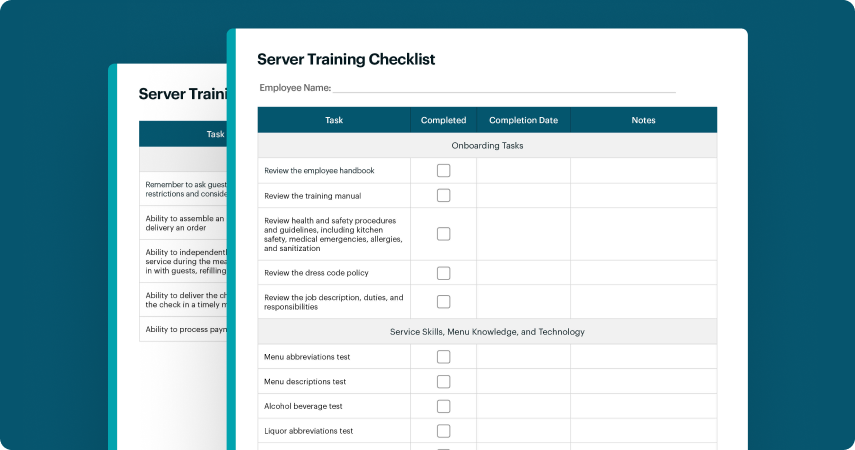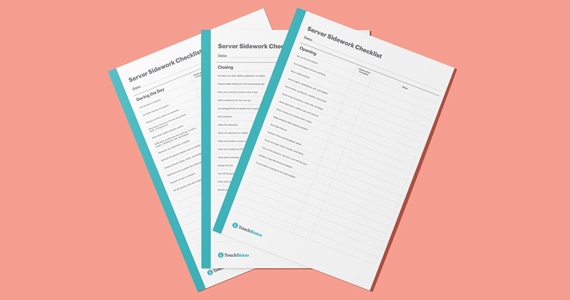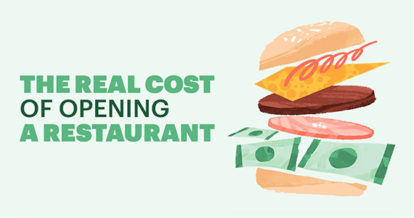Serving is challenging. From dealing with difficult customers, to fielding never-ending custom modifier requests, it’s easy to feel like you’re a one man show while waiting tables. You’re not alone – combat those feelings of inferiority, and check out these tried and true tips from industry vets to help set you up for success for what can sometimes feel like a thankless job. In the words of Celebrity Vikram Vij, “You’re a stage performer,” when working in a restaurant, so get ready to perform! Plus, they’re great tips for creating a killer server job description.

Use this checklist to help ease the training process of new servers and set them up for success.
- “It’s all about the guest! They are the first priority.”
- “You are on stage. People expect a level of hospitality and your job is to perform to that level.”
- “When asked how are you? Don’t just say fine. Go for “Awesome” or “great!” It’s more motivating!”
- “Own your excellence. The sign on our service entry door says, “Excellence is doing ordinary things extraordinarily well.”
- “Serve as you would like to be served.”
- “Don’t piss off the kitchen staff; the cooks can be your greatest allies if you make sure you show your appreciation for their hard work and you don’t make too many last minute changes to orders they’ve already begun to make.”
- “Appreciate that customers make your job possible.”
- “Connect with customers on a personal level – prove you care!”
- “Know the menu inside and out. From wine lists to specials, you should be able to answer all menu-related questions with ease.”
- “Make eye contact. It automatically makes you appear attentive and interested.”
- “Be aware of how long a customer has been waiting. There are so many things going on in a restaurant (or bar) that it’s easy to lose track of who needs attention and who doesn’t.”
- “Take a mental map of your section: mentally slotting people into spaces, working from right to left and keeping an eye out for anyone who pushed in out of turn.”
- “People want to give you money, that’s why they’re there. Offer wine suggestions, tell them the specials. Instead of asking, “Have you decided?”, ask “Can I tell you more about the menu and help you decide?”
- “Don’t underestimate the power of a smile.”
- “As soon as a glass is less than half full, ask the customer they would like another drink – don’t wait until it is empty. You always want them to have something to drink.”
- “If you’re serving more than one course, make sure any used silverware is removed and replaced prior to serving the next course.”
- “Offer excess inventory as a ‘freebie’ to patrons to make them feel like they’re receiving royal treatment.”
- “Anticipate what your tables need before they ask.”
- “Read the room. Don’t be overly chatty with couples enjoying some time together or interrupt business meetings.”
- “Don’t make your frustration visible. Make it look like you’re enjoying your job – even when you’re not.”
- “ Full hands in, full hands out! Never walk around the restaurant empty-handed. Whether it’s carrying a water pitcher to top up water, a tray to clear drinks, or clearing empty plates, you should always have your hands full because there’s always something to do.”
- “Always ask before clearing a plate.”
- “If possible, wait until everyone at the table is finished before you clear. Otherwise it can put pressure on the other guests to finish more quickly.”
- “Quality check. When a table gets their food, wait for them to take a few bites and then ask how it’s going or if they need anything.”
- “Don’t take things personally, especially when customers come across as entitled. Be conciliatory and positive interactions will go far.”
- “Unless the customer is a close friend, never sit down at the table.”
- “If you break something, such as a plate, just yell, “ANNNNNNND SCENE!” It’s a total crowd pleaser at more casual restaurants.”
- “Always work with a sense of urgency. You should never treat serving customers as though it’s a walk in the park.”
- “Say yes. It’s the essence of service.”
- “You’re on your feet your whole shift, so never underestimate the power of comfortable shoes.”
- “Humility, a passion to serve and help people, and a drive to make things better for others will be your saving grace.”
- “Offer suggestions. Whether it’s a new addition to the menu or a top-selling dish, indecisive customers appreciate suggestions.”
- “Multi-task with laser focus.”
- “If possible, be flexible with your payment options. No customer likes to hear “Sorry, we don’t accept credit cards”, or “we don’t take debit, but there’s an ATM in the corner” in this day and age.”
- “Take ownership. If one patron is bothering another, know when to step in, and what to do. Don’t ignore the situation because people are looking to you to solve problems and alleviate their discomfort.”
- “When walking behind coworkers – whether you think they are aware or not – audibly announce “behind.” If there’s a door to the kitchen, announce you’ll be entering by shouting “door”. This avoids so many collisions.”
- “Remember, the customer is always right. If an issue arises, make sure you are empowered to rectify the issue.”
- “Smile, smile, and smile – especially when you don’t feel like smiling.”
- “Be aware of how you’re using your time and make sure most of it is bringing in money. For example, offering a table a round of waters before they ask makes more work for you and often means they won’t upgrade to a pop or juice.”
- “Never refuse to seat a party of three just because they’re waiting for a fourth guest to arrive.”
- “Stay on top of 86’d items to avoid disappointment. Customers hate having to rethink their order.”
- “Always upsell. More revenue means higher bills, which means more tips.”
- “Don’t touch your face or hair while on the job.”
- “Don’t touch your guests. Apart from a professional handshake, there’s rarely a situation where making physical contact with a guest is appropriate.”
- “For restaurants near a theatre, concert hall or sports stadium, ask your guests if they have an engagement that requires they be out by a certain time so you can plan the pace accordingly.”
- “Don’t badmouth one guest to another, no matter how demanding or rude they are or how much you want to get it off your chest.”
- “When answering questions about the menu, be honest. If you’re unsure of ingredients in a menu item, ask the chef and get back to your guests, especially if it’s an allergy.”
- “Look for clues that there may be a problem, even if no one has spoken up: a scowl, a uneaten pile of food left defiantly on the plate, a hushed comment to a fellow diner while pointing at the food. Ask if there’s something wrong or if there’s something you can do.”
- “Do your upselling BEFORE customers place their orders – not after.”
- “Don’t return to a table just to ask a customer to repeat their order. If you need clarification, bring a refill or something else that will add to their dining experience.”
- “Bring all condiments before any meal arrives to avoid more any unnecessary back and forth later.”
- “Refrain from trash-talking your coworkers with guests. It says way more about you than it does about them.”
- “Don’t count money in front of patrons.”
- “Wash your hands.”
- “When promoting a special, always include the price. You may have done a great job promoting them on social, or featuring them on that big sidewalk sign, but it never hurts to ensure your patrons are fully aware.”
- “Try your best not to interrupt a table in mid-conversation. There will be a perfect time to approach, wait for it.”
- “Be patient. Don’t start clearing a table if your diners are still working on their dessert.”
- “Always let your customers know the next step. “Here are your drinks, I’ll be back in a couple of minutes to take your order. For starters, you’ve gotta try the lobster potstickers!”
- “Know your area. When a customer asks where something local is like the subway or the closest ATM, “I don’t know” can literally cost you.”
- “If a customer complains about your music selection, do something about it.”
- “Never shame a lone diner. “Just one?” has a very judgey tone. Instead, ask for a reservation, or if they’d like to be seated at the bar.”
- “Don’t forcefully interject with your favorite menu items. You might unknowingly pressure a patron into ordering that item.”
- “When asking preference for bottled or tap water, be neutral. Saying “just tap” makes it appear inferior. Ultimately, the choice is theirs.”
- “Don’t be passive when asking how their meal was. Your guests feedback could help you with your next party.”
- “Unless you’re refilling a water glass, never use the same glass for a second drink.”
- “Always ensure your guests have cutlery before bringing out any food.”
- “Never reach across one guest in order to serve another.”
- “Don’t serve a dish that doesn’t look up to standards.”
- “Know who’s order you’re bringing to the table so you can place it down in front of each guest, and you can avoid ‘auctioning off plates.”
- “Never ignore a table just because they’re not in your section.”
- “Don’t leave food sitting in the window.”
- “Clear empty glasses; a table filled with empty glasses gives off the impression that you’re ignoring your guests.”
- “Ensure the kitchen has your entrees timed so that you can bring them all out at the same time.”
- “Be interested, but not nosey.”
- “Don’t be afraid to write things down. Feeling like you have to memorize all customers orders, will only increase the potential for error.”
- “Always repeat back your guests orders, at least once.”
- “Don’t ask a customer if they’re still “working” on a dish. Dining out is not a job; ask if they’re finished.”
- “Appear calm and collected, even when you’re not. Your energy is easily transferred to the customer.”
- “Always give a customer moving through the restaurant the right of way.”
- “Make all customers feel like they’re worth your time – even if they’re just there for a round of drinks or a shared appetizer.”
- “Never ask if a customer wants their change – it’s presumptuous and makes for an uncomfortable end to their experience.”
- “Don’t overshare about your personal life; keep it professional.”
- “Go easy on the pepper and parmesan. Slow down and take the “tell me when to stop” game seriously.”
- “Go above and beyond – leave a nice note on the receipt, bring little candies, whatever works.”
- “Own up to your mistakes. If you forgot to bring out their side of mustard, don’t blame the kitchen staff. Apologize and rectify the situation as quickly as possible.”
- “Don’t just recommend only the most expensive things on your menu, as it can feel forced. Guests who are enjoying themselves without being bombarded by recommendations often spend more in the long run anyway.”
- “There’s never any reason to get down to eye level to take an order. Avoid the squat maneuver entirely.”
- “Present your guests with water and menus the second you seat them to decrease the lag time between sitting down and placing a drink order.”
- “Make sure all dishware is clean before bringing them to the table, and that glassware is rinsed and fresh.”
- “Always warn a guest if a plate you deliver is hot.”
- “Remove champagne corks quietly and gracefully.”
- “Take all personal conversations off of the floor; customers should be out of earshot while you’re gabbing with your co-workers.”
- “Never eat or drink within plain sight of guests.”
- “Don’t say “No problem”, some guests may take that as an insincere response. Instead, say “My pleasure” or “You’re welcome.”
- “Cursing is unacceptable, no matter how young and hip your guests may be.”
- “If there’s a service charge, bring it to your guests attention when you present the bill.”
- “Always face a patron while they’re ordering. Make eye contact and give them your undivided attention.”
- “Always remove and replace used silverware between courses.”
- “Never force a patron to settle up their bar tab before being seated; transfer the tab when possible.”
- “Don’t bring the cheque until it’s requested.”
- “Be a reliable line of communication between the customer and the kitchen.”
- “Your smartphone should never be used in plain sight of a patron.”
- “Be courteous while addressing customers; don’t call them “dude” or “girls”.
- “Your own eating habits are irrelevant, don’t bring them up. Assume your patrons aren’t interested in hearing about your struggle with gluten.”
- “If your chef tells you a plate is hot, it’s hot. Don’t find out the hard way.”
- “Carry extra pens in your apron for when your guest needs to sign their cheque, and expect them to go missing.”
- “Communicate clearly. No mumbling!”
- “Maintain proper hygiene; keep your hair neat and facial hair under control.”
- “Smile and greet guests, even if they’re not in your section.”
- “Be a straight-talker; get to the point, but do so politely.”
- “Tell guests your name so they can easily get your attention, if needed.”
- “Follow up with a table no less then 90 seconds after serving.”
- “Serve from the left, retrieve from the right.”
- “Keep your guests informed at all stages. A simple ‘Your entrees will be right out.’ will do.”
- “Avoid going right to another table after taking an order. When possible, enter orders into your POS system right away.”
- “Explain menu terms with a positive attitude. Not everyone knows what confit is, so be sensitive and help them understand.”
- “Avoid passive, uninformed phrases like: “Hang on”, “Let me check”, or “I don’t know.”
- “Accept the negatives. Find ways to deal with unhappy customers so that you can continue doing your job and make your other customers happy.”
- “Your mood and energy sets the tone for your guests’ entire experience, so fake it till you make it.”
- “Question the customer so you can actually give them what they want. They’ll be more likely to trust the recommendations you give.”
- “Always ask questions that will end in a sale response. For example, “What can I get you to drink?” Instead of, “Does anybody want a drink?””
- “Always put the customer’s needs before your own.”
- “Two words: Be attentive.”
- “Understand that you are the host and your customers are the guests. They came to you for an experience, so treat them as if you were entertaining them in your very own home.”
- “Get to know your customer’s needs, wants, and expectations. Do this right, and no one will ever leave disappointed.”

Keep servers on task with this free, ready-to-print server sidework checklist.
Download your free employee handbook template
Sign up for our free weekly TouchBistro Newsletter







